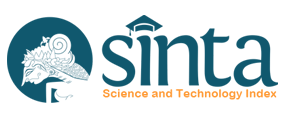DYNAMIC ANALYSIS OF ISLAMIC AND CONVENTIONAL MONETARY INSTRUMENTS TOWARDS REAL SECTOR GROWTH IN INDONESIA
Abstract
Keywords
Full Text:
PDFReferences
Ascarya. 2009. “Alur Transmisi dan Efektifitas Kebijakan Moneter Ganda di Indonesia”. Jurnal. [unpublished]
___________ 2009. The Determinant of Inflation under Dual Monetary System in Indonesia.
___________ 2008. “Menuju Sinergi Optimal Kebijakan Moneter dalam Sistem Keuangan Perbankan Ganda”. Jurnal. JEBI Vol. 23, No. 1, January 2008.
Bank Indonesia. Annual Reports.
Balamoune-Lutz, M. 2003. Financial Liberalization and Economic Growth in Morocco: A Test of the Supply-Leading Hypothesis. The Journal of Business in Developing Nations. Volume 7, pg. 31-50.
Chapra M Umer. 1992. “Islam and the Economic Challenge”. The Islamic Foundation, Leicester UK.
___________. 1996. Monetary management in an islamic economy. islamic Economic Studies, vol 4, no 1, december 1996
CEIC Report.
Enders, W. 2000. Applied Economic Time Series. John Wiley & Son, Ltd. New York, USA.
Feridhanusetyawan, Tubagus. 1999. “The Social Impact of The Indonesian Economic Crisis: Labor Market Adjustments”. The World Bank-ISEAS Research Project on the Social Impact of the Asian Economic Crisis Gujarati, D. 2003. Basic Econometrics. Singapore: Mc Graw-Hill.
Howard Jamal. 2011. Gold Standard – The Future For a stable Global Currency. November 2011/ Dhu al hijjah 1432 H. Hizbut tahrir
Ibrahim, Mansor H. 2006. “Monetary Dynamics and Gold Dinar: An Empirical Perspective”. International Islamic University Malaysia, Kuala Lumpur, Malaysia.
John Sloman, Kevin Hinde, Dean Garrat. 2010. Economics for Business fifth edition, Prentice Hall. England
Kasri, R. A. and Kassim, S. 2009. Empirical Determinants of Saving in The Islamic Banks: Evidence From Indonesia. J.KAU: Islamic Economics., Vol. 22 No. 2, pp: 3-23 (2009 A.D./1430 A.H.).
Kassim, S. H. and Majid, S. A. 2009. Sensitivity of the Islamic and conventional banks to monetary policy changes: the case of Malaysia. International Journal of Monetary Economics and Finance, Volume 2, Number 3-4 / 2009, pg. 239 - 253.
Laksani, C.S. 2004. “Netralitas Uang di Indonesia melalui Analisis Efektifitas Uang Beredar dalam Mencapai Tujuan Makroekonomi”. [Script]. Bogor Agricultural University.
Meera, Ahamed Kameel Mydin. 2004. The Theft of Nations. Pelanduk Publications, Malaysia.
___________. 2002. The Islamic Gold Dinar. Reviewed by Mohamed Obaidullah 2004. J.KAU: Islamic Economics, Vol 16 No. 2, pp 35-39 (1414 AH/2003 AD), Pelanduk Publications, Malaysia.
___________.and Moussa Larbani. 2006. “Seigniorage of Fiat Money and the Maqasid alShari’ah: The Compatibility of the Gold Finar with the Maqasid”. Humanomics, Vol 22, No. 2, 2006, pp.84-97
McCoy, D. 1997. How Useful is Structural VAR Analysis for Irish Economics?. A Paper Presented at an Internal Seminar of the Central Bank of Ireland, February 6th 1997, and at the 11thAnnual Conference of the Irish Economics Association, 4-6 September 1997, Athlone.
Nathan, Lewis. 2007. Gold the One and Future Money. John Wiley & Sons, Inc.
Rosidi, A. 2000. Industrial Production Index, Wholesale/Producer Price Index, Consumer Price Index of Indonesia. Country Paper for the Joint OECD/ESCAP Workshop on Key Economic Indicators, Bangkok 22-25 May 2000.
Rosly, Saiful Azhar. 2005. Critical Issue on Islamic Banking and Financial Markets. Dinamas Publishing, Malaysia.
Thomas, R.L. 1997. Modern Econometrics an Introduction. First Edition. London: Westley Longman Ltd.
Yusof, R. M., M. Wosabi, and M. S. A. Majid. 2008. Monetary Policy Shocks and Islamic Banks Deposits in a Dual Banking System: A Comparative Analysis between Malaysia and Bahrain. 8th Global Conference on Business and Economics.
DOI: https://doi.org/10.32507/ajei.v3i1.348
Refbacks
- There are currently no refbacks.
Copyright (c) 2018 Qurroh Ayuniyyah, Rico Ricardo, Nursechafia Nursechafia, Yuni Yulia Fakrikha
Indexed by:
© Copyright CC BY-SA Al-Infaq: Jurnal Ekonomi Islam, p-ISSN: 2087-2178, e-ISSN: 2579-6453 |






.png)